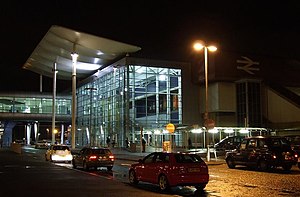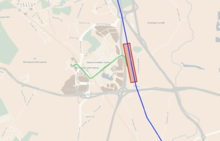Birmingham International railway station
This article needs additional citations for verification. (October 2010) |
Birmingham International | |
|---|---|
 Entrance to the station | |
| Location | Birmingham Airport, Metropolitan Borough of Solihull England |
| Coordinates | 52°27′04″N 1°43′30″W / 52.451°N 1.725°WCoordinates: 52°27′04″N 1°43′30″W / 52.451°N 1.725°W |
| Grid reference | SP187837 |
| Managed by | Avanti West Coast |
| Transit authority | Transport for West Midlands |
| Platforms | 5 |
| Other information | |
| Station code | BHI |
| Fare zone | 5 |
| Classification | DfT category B |
| History | |
| Original company | British Rail |
| Key dates | |
| 26 January 1976 | Opened |
| Passengers | |
| 2016/17 | |
| 2017/18 | |
| 2018/19 | |
| Interchange | |
| 2019/20 | |
| Interchange | |
| 2020/21 | |
| Interchange | |
| Location | |
 | |
| Notes | |
Passenger statistics from the Office of Rail and Road | |
Birmingham International is a railway station located in Solihull in the West Midlands, to the east of the city of Birmingham, England.
The station is on the Rugby–Birmingham–Stafford Line 14 km (8½ miles) east of Birmingham New Street and serves Birmingham Airport, National Exhibition Centre (incorporating the Resorts World Arena) and Resorts World Birmingham.
History[]
The station was designed by the architect Ray Moorcroft and opened on 26 January 1976,[1] and has regular train services to many parts of the country. It was named Birmingham International after the adjacent airport which was at the time named Birmingham International Airport, but has since been rebranded as Birmingham Airport. The large space under the overbridge to the left of the southbound platforms suggests space was allowed for future expansion of the station.
In 2016 it was proposed to rename it to Birmingham Airport & NEC, due to the airport's name change and the near presence of the National Exhibition Centre.[2]
Services[]
The station is managed by Avanti West Coast and is also served by CrossCountry, Transport for Wales and West Midlands Trains. It has five platforms, consisting of two islands and one side platform numbered 1-5 from south to north.

The basic off-peak service is as follows:
- 2 trains per hour to London Euston
- 2 trains per hour to Birmingham New Street, of which
- 1 train per hour continues to Blackpool North/Edinburgh Waverley (alternating each hour) via Wolverhampton and Preston
- 2 trains per day continue to Shrewsbury via Wolverhampton and Telford Central
During rush hour certain Avanti West Coast services to/from London Euston start and terminate here.
CrossCountry[4]
- 1 train per hour to Manchester Piccadilly via Macclesfield
- 1 train per hour to Bournemouth via Reading
- 1 train per hour to Shrewsbury, of which:
- 1 train per two hours continues to Aberystwyth and Pwllheli after dividing at Machynlleth
- 1 train per two hours continues to Holyhead via Wrexham General and Chester
West Midlands Trains[6]
- 4 trains per hour to Birmingham New Street, of which:
- 2 trains call at Marston Green only, under the London Northwestern Railway brand
- 1 train starts here and calls at Marston Green, Lea Hall, Stechford and Adderley Park and continues to Rugeley Trent Valley, under the West Midlands Railway brand
- 1 train starts here and calls at Marston Green, Lea Hall and Stechford, under the West Midlands Railway brand
- 2 trains per hour to London Euston via Northampton calling at Hampton-in-Arden, Berkswell, Tile Hill, Canley and principle stations to London Euston, under the London Northwestern Railway brand
| Preceding station | Following station | |||
|---|---|---|---|---|
| Coventry | Avanti West Coast London Euston-Edinburgh Waverley/Glasgow Central via Birmingham New Street |
Birmingham New Street | ||
| Avanti West Coast London Euston-Birmingham New Street |
||||
| CrossCountry Bournemouth/Reading-Manchester Piccadilly |
||||
| Berkswell | London Northwestern Railway London Euston - Birmingham New Street via Northampton Some services extend to Rugeley Trent Valley |
Marston Green | ||
| Hampton-in-Arden | Birmingham New Street | |||
| Terminus | Transport for Wales Birmingham International-Chester/Holyhead |
Birmingham New Street | ||
| Transport for Wales Cambrian Line Birmingham International-Aberystwyth/Pwllheli |
||||
| Terminus | West Midlands Railway Birmingham International-Rugeley Trent Valley |
Marston Green | ||
| West Midlands Railway Birmingham International-Birmingham New Street |
||||
| Hampton-in-Arden | West Midlands Railway Coventry-Birmingham New Street (Limited service) |
Marston Green | ||
| Preceding station | AirRail Link | Following station | ||
| Terminus | AirRail Link (Formerly Maglev) | Birmingham Airport | ||
Connection to Birmingham Airport[]

A maglev service ran from the airport terminal to the station from 1984 until 1995. The train "flew" at an altitude of 15 mm over a track 620 m in length. It operated for nearly 11 years, but was scrapped because spare parts for the system were no longer available. It was temporarily replaced by a bus.
The chosen replacement system, the Doppelmayr Cable Car Cable Liner Shuttle, was announced in late 2000 and construction started in 2001. The Interchange was opened in March 2003. The system was originally known as SkyRail but in 2004 it was renamed AirRail Link.
The airport can also be reached via a dedicated fast bus service from Coleshill Parkway station, on the Birmingham to Peterborough Line.
Connection to the National Exhibition Centre[]
Under cover walkways, escalators and Travelators connect the NEC buildings to the station and to the Air-Rail Link, which in turn connects to Birmingham Airport.
Birmingham interchange[]

A new Birmingham Interchange railway station is to be built on the other side of the M42 motorway from the National Exhibition Centre, Birmingham Airport and this station.[7] The new interchange would be connected by a "rapid transit people mover" to the other sites; the AirRail Link people mover already operates between Birmingham International station and the airport.
References[]
- ^ Butt, R.V.J. (1995). The Directory of Railway Stations. Yeovil: Patrick Stephens Ltd. p. 34. ISBN 1-85260-508-1. R508.
- ^ Jones, Tamlyn; Bannister, Antonia (30 August 2016). "Birmingham International train station to change its name". CoventryLive.
- ^ GB eNRT, Tables 65, 66 & 68
- ^ GB eNRT, Table 51
- ^ GB eNRT, Tables 74 & 75
- ^ GB eNRT, Table 68
- ^ Department for Transport (11 March 2010). High Speed Rail - Command Paper (PDF). The Stationery Office. p. 118. ISBN 978-0-10-178272-2. Retrieved 13 March 2010.
External links[]
| Wikimedia Commons has media related to Birmingham International railway station. |
- Railway stations in Solihull
- Airport railway stations in the United Kingdom
- Railway stations opened by British Rail
- Railway stations in Great Britain opened in 1976
- Railway stations served by CrossCountry
- Railway stations served by Transport for Wales Rail
- Railway stations served by Avanti West Coast
- Railway stations served by West Midlands Trains
